Todoist vs. Google Tasks Summary
Who is Todoist for?
Todoist is one of the most feature-rich to-do app currently available. Unlike other to-do apps, Todoist is entirely focused around adding, managing and completing tasks.
By contrast, other to-do apps combine task management with other features such as habit tracking or Pomodoro timers.
Thus, Todoist is primarily designed for users that want a to-do app with as many features as possible.
Who is Google Tasks for?
Google Tasks is a task management app that is simultaneously extremely easy to use, but also very simple and limited in what features it offers. It does however have an excellent integration with Google Calendar.
This ease of use and limited features makes Google Tasks perfect for users who just need an app where they can write down a task, set a reminder and have it synchronized with Google Calendar.
In exchange for this simplicity, users sacrifice various features such as customization, collaboration, complex calendar views, organization and filters etc.
Ease of use
Todoist ease of use
Todoist’s interface is clean and minimalistic, only showing you a few buttons and navigation menus.
The first screen you see when opening the app is called the “Inbox”. From there you can add, edit or complete tasks.
You can also better organize the Inbox by adding different sections to it, such as Work, Parenting or more.
What we like about Todoist’s interface is that the buttons for “View” and “Options” reveal a lot of powerful functionality such as multiple filter types, sorting options, activity logs, comments etc.
One feature we really liked was the ability to select multiple tasks at once and modify them by adding tags, labels, changing priority levels or moving them to different projects or sections.
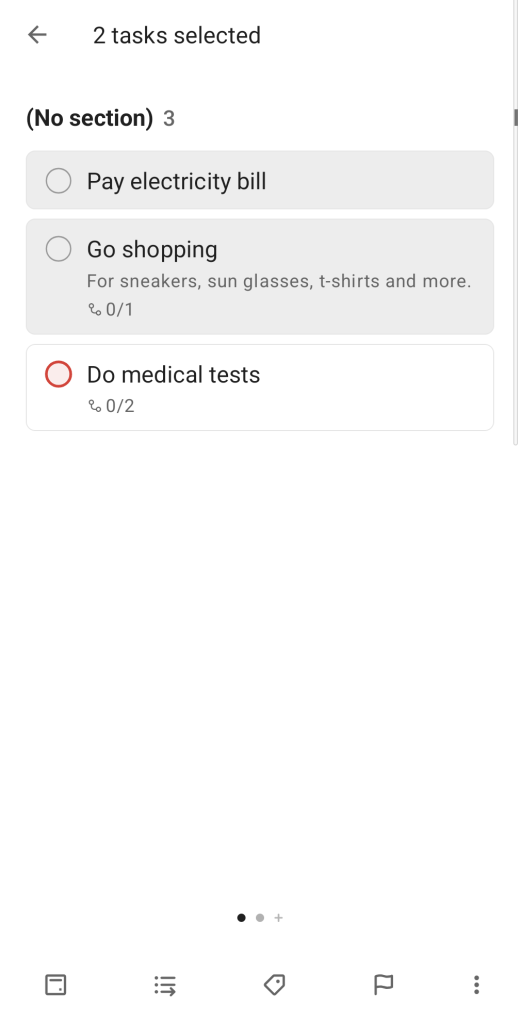
Almost no other task management app has this, so you have to edit tasks one by one.
Overall, Todoist has a simple interface, but it elegantly places its settings options in multiple, relevant locations.
This allows you to learn Todoist at your own pace, without feeling overwhelmed by the number of settings and options available.
Google Tasks ease of use
Google Tasks is probably one of the easiest to use task management currently available.
You open the app and all you see is a simple screen where you see:
- Your lists of tasks.
- Favorite tasks.
- An Add Task button
- Completed tasks.
That’s it.
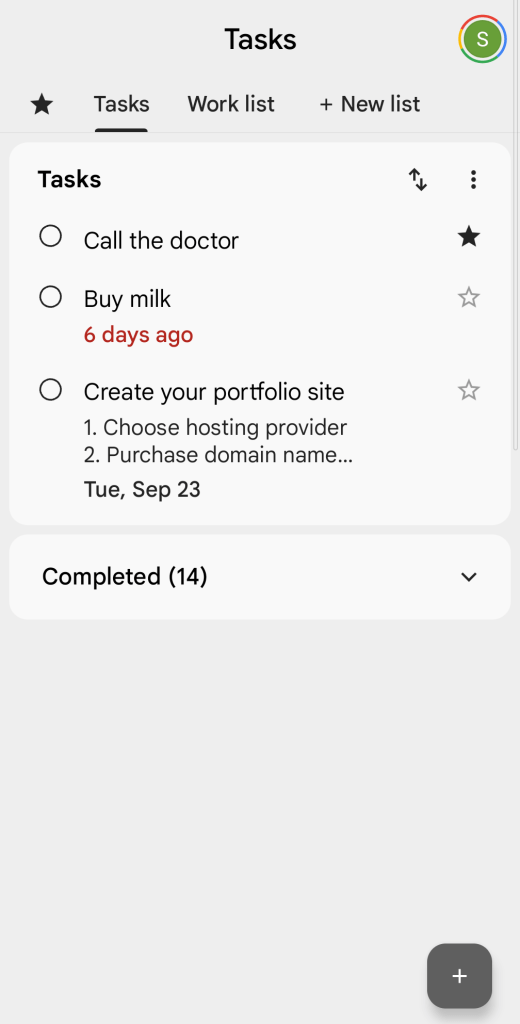
No tagging features, no collaboration, no calendar view, no filters etc. Google Tasks doesn’t even have a Settings button.
On a psychological level, this makes Google Tasks feel very low stress since opening and using the app doesn’t feel like work.
Organization
Todoist organization
Todoist lets you organize your tasks in multiple ways:
- Inbox. Contains all tasks and sections that don’t belong to a project.
- Projects: such as Work, School, Family etc.
- Sections. These are basically lists within projects.
- Priority: from 1 to 4, where 1 is most urgent.
- Labels: custom labels you can attach to any task.
- Subtasks: divide a large task into multiple smaller tasks.
In other task management apps, this level of organization would make them very hard to navigate. This is because you would constantly have to move between different projects, sections or labels to find the tasks you want.
Todoist solves this problem through a powerful filter function that lets you combine multiple sorting options into a single filter.
For example, you can create a filter that only retrieves tasks in the Work project, have a priority of 1, and are labelled as “Reports”.
This filter function is unique to Todoist, and is incredibly useful for dedicated users that have dozens of active tasks all the time.
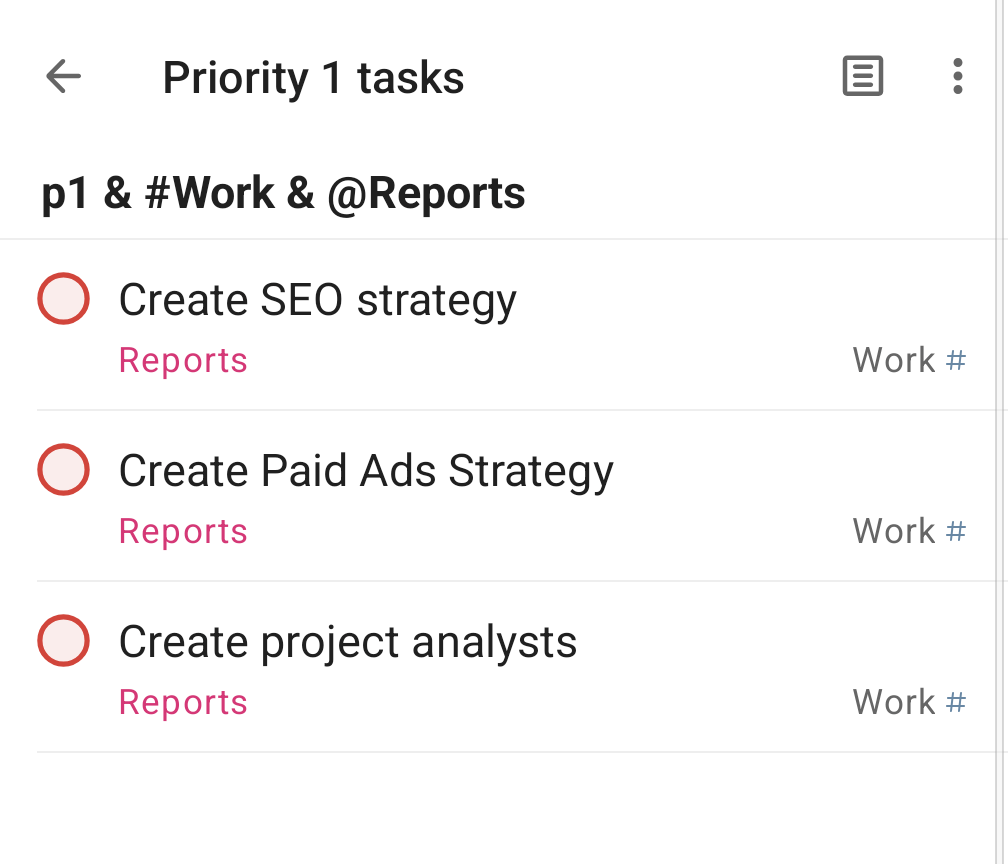
Finally, there’s also a search function that is buried deep within the settings of the app.
Google Tasks organization
Google Tasks lets you organize tasks in 3 ways:
- Lists
- Subtasks.
- Tasks saved to Favorites.
The absence of a tagging feature is very noticeable, since many users rely on that feature to better sort and organize their tasks.
You can however save certain tasks to a Favorite list which can contain tasks from all of your lists.
Google Tasks lets you create subtasks for each task. However, the app does not let you create a chain of subtasks.
For example, in Todoist and TickTick, you can attach a subtask to a subtask, and then another subtask to that subtask.
In Google Tasks, this is not possible and you can only have a main task/sub task organization.
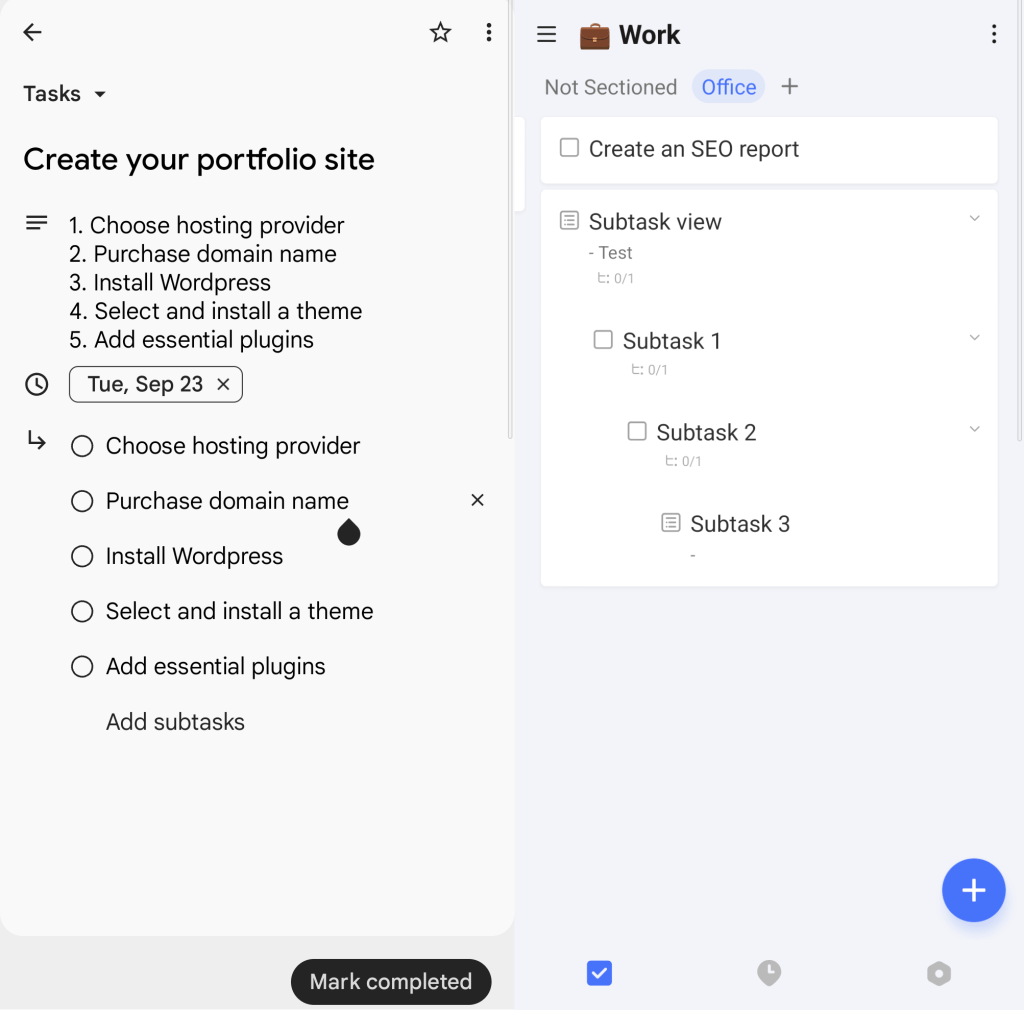
Very importantly however, subtasks in Google Tasks function as normal tasks, meaning you can attach individual descriptions and reminders for every subtask.
Although these features might seem basic, not all task management apps allow such features for subtasks.
Finally, Google Tasks only has basic sorting features where you can sort tasks by date, title, default order or recently saved.
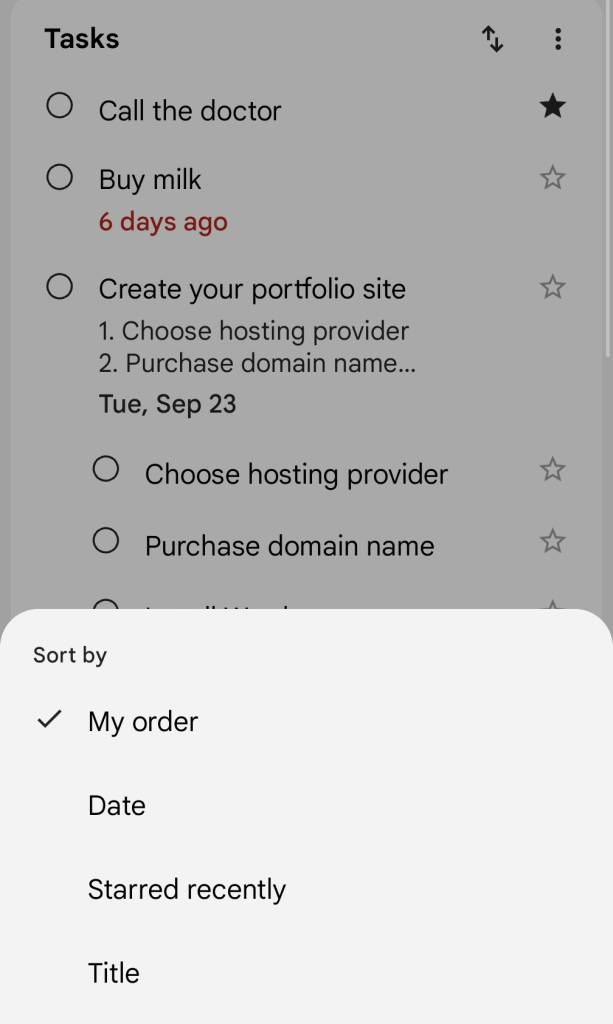
Scheduling and reminders
Todoist scheduling and reminders
Todoist lets you schedule tasks that are one time only, or tasks that repeat themselves at regular intervals.
For repeating tasks, you can schedule them in lots of different configurations:
- Repeats every week, but only on Fridays and Saturdays.
- Repeats once every 3 months.
- Repeats every month on the same day (10th for example).
- Repeat every 2 months.
- Repeats every 3 weeks.
- Etc.
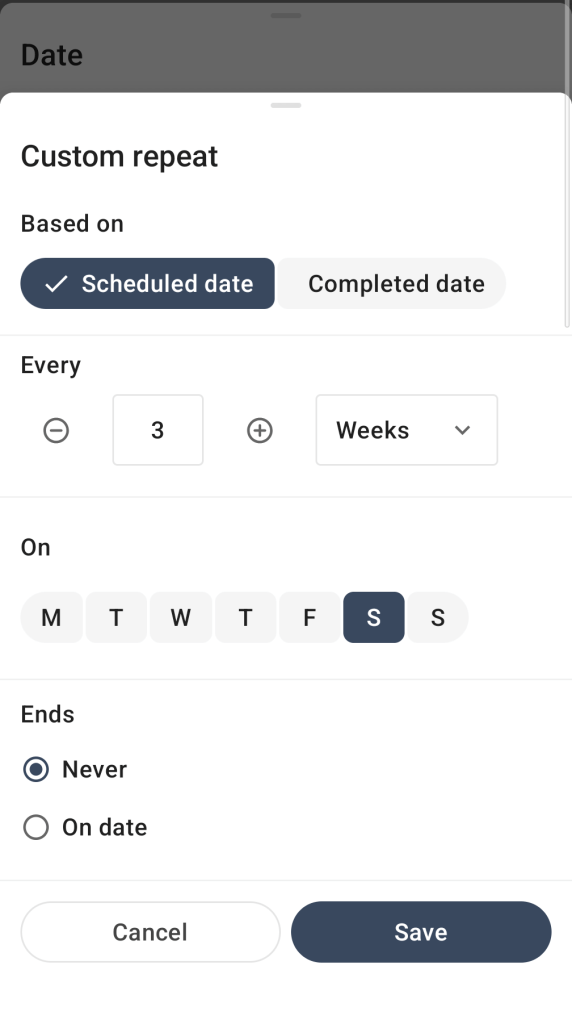
The paid version of Todoist adds other very useful reminder features:
- Extra reminders for a task (free version only allows 1 reminder per task)
- Deadline feature.
- Task duration for calendar view.
- Location reminder.
Google Tasks scheduling and reminders
Google Tasks scheduling and reminder features is better than nearly every other to-do app on the market.
Tasks can be scheduled to be either one time only, or to repeat themselves at regular intervals.
Repeating tasks can be scheduled in every possible configuration:
- Repeats every week, but only on Fridays and Saturdays.
- Repeats once every 3 months
- Repeats every month on the last Friday
- Repeats every 3 weeks.
- Etc.
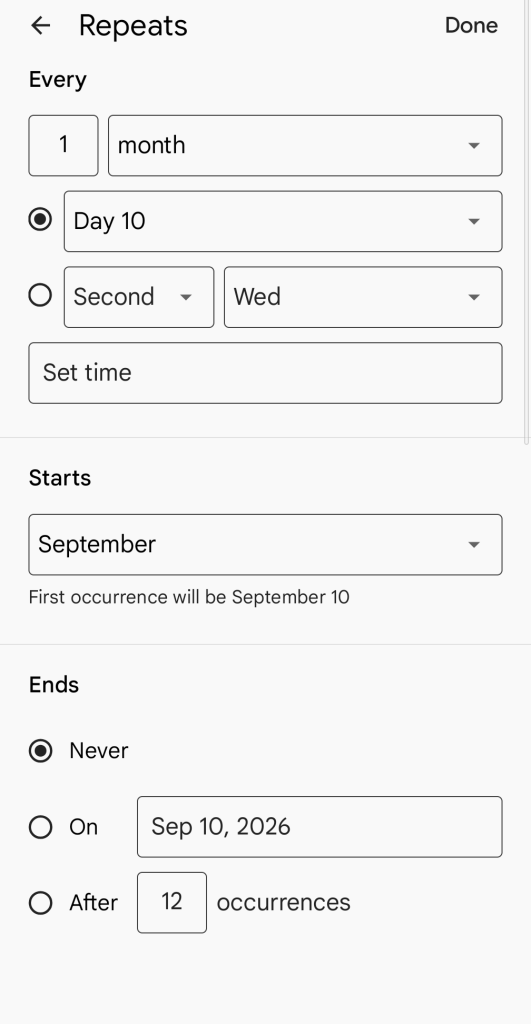
We would have liked it if Google Tasks had the option to attach multiple reminders to a single task (such as 1 hour before start, 30 minutes before start, 10 minutes etc.) but that’s a minor complaint.
Calendar and other integrations
Todoist calendar and other integrations
Currently, Todoist integrates with Google Calendar and Outlook Calendar, but no Apple Calendar unfortunately.
This is a pain point for iOS users, but there are certain workarounds for this. For example, you can synchronize Google Calendar with Apple Calendar.
Afterwards Todoist tasks added to Google Calendar are automatically pushed to Apple Calendar as well. While not 100% perfect, it should be good enough in most situations.
However, Todoist has a big advantage over competitors because it has 80+ integrations with many other productivity programs.
For example, Todoist can integrate with:
- Note taking apps: Evernote, Capacities, Fireflies etc.
- Time tracking: 2Day, Toggl, Flowmo etc.
- Email: Gmail, Outlook, Spark, Airmail etc.
- Messaging: Slack, MS Teams.
- And many other integrations.
Todoist has so many integrations, it’s almost guaranteed you will find at least one that will fit your needs.
Google Tasks calendar and other integrations
One of the biggest advantages of using Google Tasks is its deep integration with Google Calendar. This integration is automatic, you don’t need to do anything.
Adding a reminder to a task automatically creates a Google Calendar entry, without you having to synchronize Google Tasks and Google Calendar.
Unfortunately, Google Tasks doesn’t provide the option to directly integrate with other calendar apps such as iCal or Outlook Calendar,
Finally, Google Tasks doesn’t directly integrate with other programs such as Notion, Evernote, Slack etc.
Instead, you will have to integrate other apps with Google Calendar, and any information those other apps save into Google Calendar should be viewable into Google Tasks as well.
AI Features and Integrations
Todoist AI Features and Integrations
The free version of Todoist doesn’t have any integration with AI/LLMs such as ChatGPT or Gemini.
To get an AI integration you’ll need a paid subscription, and even the AI feature will only work on the desktop version of Todoist (so not available on Android/iOS).
However, Todoist has an excellent system of natural language processing, which makes the need for an AI integration mostly obsolete.
Natural language processing allows a user to type a single, coherent line of text that the app intelligently understands and then sets the task title, but also its due date, project, labels, and priority level.
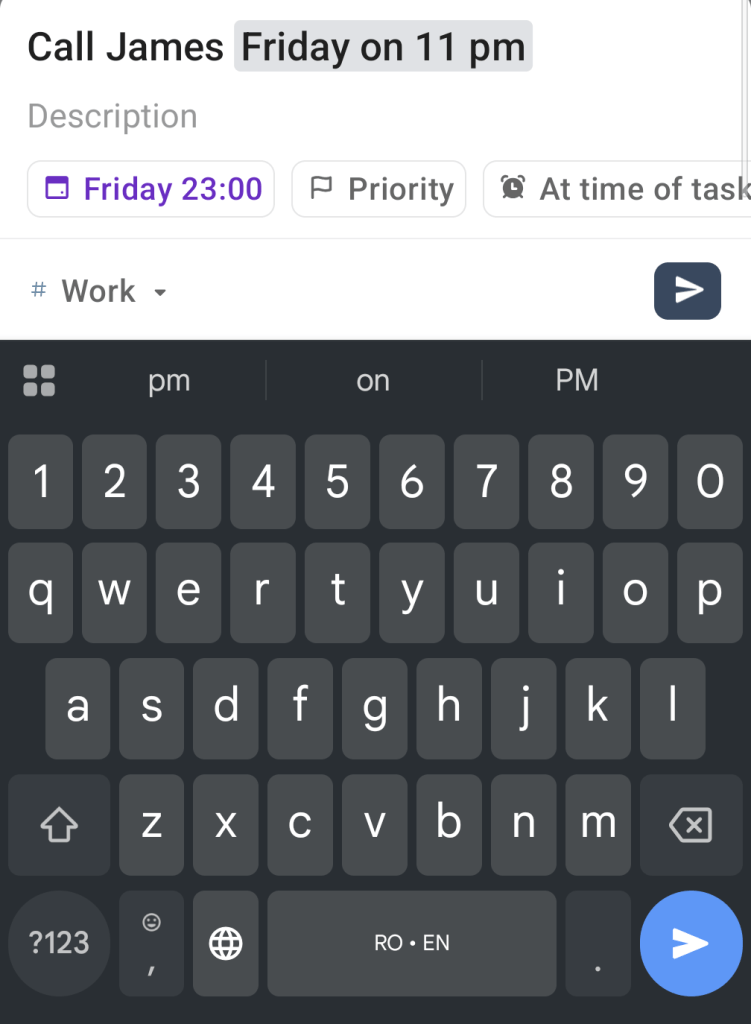
Google Tasks AI Features and Integrations
Google Tasks doesn’t have any AI features within the app, meaning there aren’t any buttons or options where you can ask an AI to create tasks or reminders.
Instead, Google Tasks integrates with Gemini or Google Assistant, and you can create or read tasks from those apps.
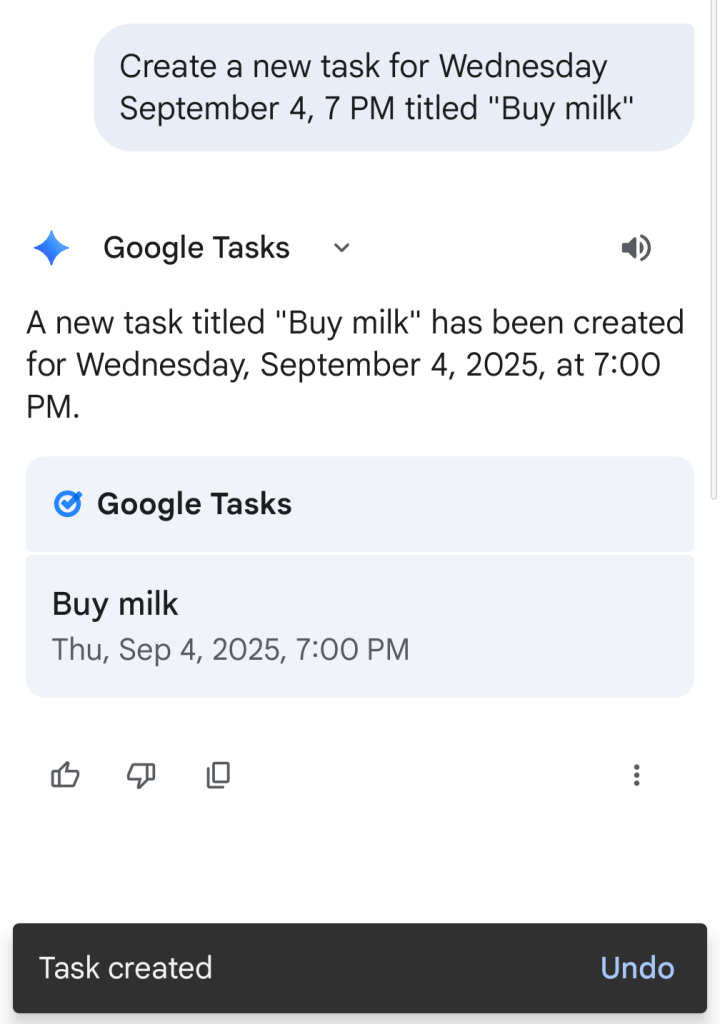
Based on our usage, Google’s own Gemini app seems to work best with Google Tasks, but it does have limitations. For example, Gemini can’t break down a large task into subtasks.
Other AI tools such as ChatGPT or Claude can also be integrated into Google Tasks/Calendar, but requires you to setup a Zapier account to do so.
Special or unique features
Todoist special or unique features
Todoist has many interesting features built into the app. Here are the ones we think are most noteworthy:
- Natural Language Processing. This allows you to create and schedule tasks simply by writing what you need instead of pressing buttons and navigating menus.
- Powerful filtering functions. Todoist has the most powerful filtering and sorting function of any task management app we’ve tested. This can greatly help users who tend to have dozens or hundreds of active tasks.
- Karma score. Todoist’s Karma transforms productivity into a game. Users gain points when completing tasks, but lose points when tasks are overdue. As users accumulate points, they advance through eight distinct Karma levels, starting at “Beginner” (0-499 points) and progressing all the way to “Enlightened” (50,000+ points).
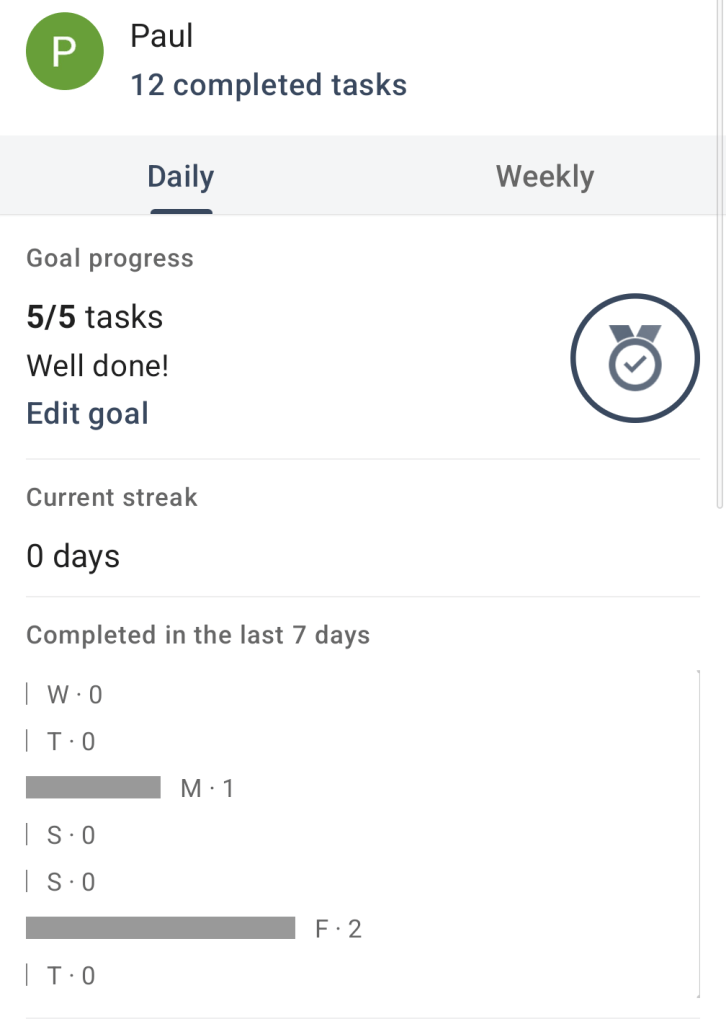
Google Tasks special or unique features
Google Tasks is very simple compared to many of its competitors, but it still has a few, highly distinct features:
- Integration with Gemini/Google Assistant. It feels very nice to chat with an AI about your tasks, or to ask the AI to create new tasks itself. Unfortunately, you have to use Gemini for this to work properly.
- Excellent integration with Google Calendar. Google Tasks has the best integration with Google Calendar out of any task management app we’ve tested.
- Overall simplicity. Google Tasks has very few features compared to competitors, but this also makes the app very simple to use and understand.
Cross-platform compatibility
Todoist cross-platform compatibility
Todoist can be downloaded on the following platforms:
- Desktop/laptops: Windows and macOS.
- Mobile: Android and iOS.
- Other: Android and iOS smartwatches.
Todoist also has web versions for both mobile and desktop.
Google Tasks cross-platform compatibility
Google Tasks can be downloaded on the following platforms:
- Mobile: Android and iOS.
- Other: Android and iOS smartwatches.
Importantly, Google Tasks doesn’t have a downloadable version for Windows or macOS. For those platforms you will have to use the web version instead.
Collaboration and sharing
Todoist collaboration and sharing
Todoist comes with many collaboration features, even in the free version.
To collaborate with someone, you create a project, such as “Work” and then invite someone else to edit that project.
The free version allows you to create 5 projects, and for each project you can invite up to 5 collaborators.
Todoist Business offers many common project management features such as: team projects, task comments, notes, file uploads etc.
That being said, Todoist Business cannot fully replace project management tools such as Trello or Asana because it doesn’t have many essential features such as: work boards, Kanban views, Gantt charts, workload views etc.
Todoist also doesn’t have many powerful automation features such as:
- Sending notifications to certain people, but only on certain channels.
- Real time collaboration on certain documents or projects.
- Deep integrations with CRMs such as HubSpot or Salesforce etc.
In general, the collaboration features found in Todoist should be sufficient for small teams and families, but anything larger than that requires a dedicated project management tool.
Google Tasks collaboration and sharing
Google Tasks has no built-in collaboration features. This means you cannot share a shopping list with your partner, or share a list of work tasks with your colleagues.
Any task saved into Google Tasks is yours and only yours.
The only exception to this is for companies that have paid for and set up a Google Workspace. From within Google Workspace, a person can share or assign tasks to others from within Gmail, Google Chat etc.
Pricing
Todoist pricing
The paid version of Todoist has two different subscription plans:
- Pro: $5 per month / $48 yearly ($4 per month).
- Business (per user): $8 per month / $72 per year ($6 monthly).
The paid version of Todoist unlocks numerous features:
- 300 personal projects (free version has 5).
- AI assistant.
- Deadlines feature.
- Custom reminders. Ability to add more reminders for each task.
- Deadlines.
- Task duration.
- Team collaboration (for business users).
Google Tasks pricing
Google Tasks is completely free.